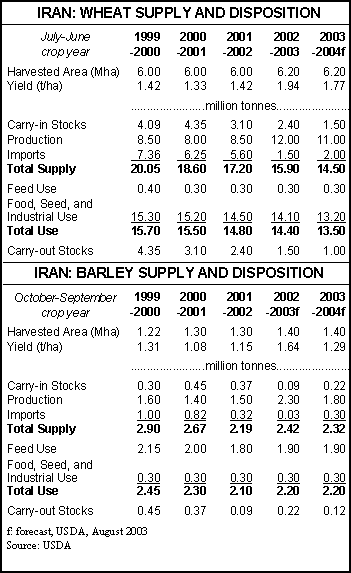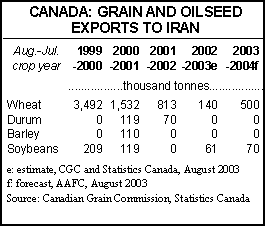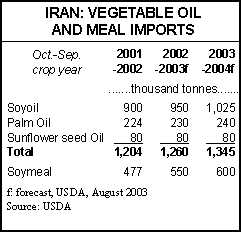Publications: Bi-weekly Bulletin
2003-08-29 | Volume 16 Number 15 | ISSN 1494-1805 | AAFC No. 2081/E
Iran: Situation and Outlook
Iran is currently one of the world's largest net importers of agricultural products, importing 30-50% of its requirements. Rapid population growth and higher disposable income are expected to increase the demand for food over the medium and long-term. Trade missions between Canada and Iran have succeeded in creating opportunities over the medium and long-term in agricultural imports, particularly for canola and canola oil. This issue of the Bi-weekly Bulletin examines the situation and outlook for Iran's agricultural sector and prospects for trade with Canada.
Background
The Islamic Republic of Iran is a growing market that maintains an important trade relationship with Canada. Although the country's economy has struggled since the late 1980s, progress has occurred in economic diversification and social modernization. Governed by Islamic principles, the government, led by Mohammed Khatami, who secured a final term in June of 2001, is supporting debt reduction, economic liberalization, and the promotion of trade.
Economy
The population of Iran, estimated at 70 million, is growing at an annual rate of about 0.7%. Iran's gross domestic product (GDP) is estimated at US$115 billion, which equates to about US$1,640 per person. The services sector accounts for 39% of Iran's economic activity, followed by agriculture at 25%, and manufacturing and mining at 22%. Iran's economy is heavily reliant on oil revenues. Oil accounts for about 80% of the value of its annual exports.
The Iranian government has made debt reduction one of its top priorities to improve access to longer term financing, as Iran had to reschedule much of its foreign debt in 1992.
Banks have expanded their lending to the private sector and public enterprises, the trade regime has been further liberalized, and a program has been adopted to replace non-tariff trade barriers with tariffs.
Although traditionally an agricultural society, Iran has achieved significant industrialization and economic modernization in the past 20 years. The economy is a mixture of central planning and private ownership, with the state governing the oil industry and other large enterprises. The government manages the economy through five year plans.
Agriculture
Though in decline, the agricultural sector is a significant contributor to the GDP and employment in Iran.
Iran's agricultural sector accounts for 25% of the gross national product , 23% of job creation, 21% of non-oil exports, 80% of domestically needed foodstuffs and 90% of the raw materials used in food processing plants.
Geographically, Iran has a total area of 1.65 million square kilometres (about 165 million hectares (Mha), of which 7.5% is suitable for agriculture. The climatic conditions in much of Iran are typical of arid and semi-arid regions, while the Caspian coast is subtropical. Both tropical and cool-season crops - such as dates, pistachios, sugarcane, rice, apples, cherries, walnuts, etc. - are extensively cultivated. However, much of the arable land is devoted to growing wheat and barley, which are staple foods and the main sources of protein for the average Iranian. Wheat alone covers about 60%, while various fruits account for 15% of the total irrigated land in Iran (2000 estimate).
Two farming systems - man-made irrigation and non-irrigated (rain-fed) - are primarily used in different parts of the country, and the area devoted to each system varies considerably depending on agro-climatic conditions.
Non-irrigated production is most successful in western and northwestern Iran, as well as the lowlands along the Caspian coast. In the central plateau, as well as the southern plains and the southern coastal areas of Iran, crop production is mostly possible only with irrigation, due to low rainfall and high evaporation rates. In some low-lying plains in the central plateau, the annual rainfall is about 50 millimetres (mm) while the annual evaporation may exceed 4,000 mm. The country-wide average precipitation is about 250 mm a year.
Approximately 11% of the country's total area is used for crop production. Of this, about 10.2 Mha is cultivated (irrigated and non-irrigated), while nearly 5.8 Mha is left as fallow every year. An estimated 32 Mha of unused land are potentially suitable for crop production, but a shortage of water limits their agricultural role. More than half of the country consists of rangeland (generally of low to medium productivity), wasteland, and mountains. Sand dunes, salt flats, and other non-productive land, found mostly in the central plateau and the southern coastal areas, comprise 11.6 Mha. Due to relatively small area available for crop production, Iran is working towards increasing its agricultural efficiency.
To increase its efficiency, the agriculture sector of Iran is attempting to improve its mechanization. Iran's rate of mechanization is about 0.5 horsepower per acre (hp/ac.), much lower than the 30 hp/ac average for developed countries. The average farm in Iran is about 20 hectares (ha). The Ministry of Agriculture is encouraging farm owners to form co-operatives (co-ops), to increase the size of farms to about 200-500 (ha). With these larger farms, there is a need for larger farm equipment which is expected to increase the rate of mechanization. These farm co-ops have lobbied for increased government spending in the agricultural sector including modernization as a means of alleviating the effects of recent and future droughts. With Iran's large oil reserves, the Iranian government and newly formed co-ops are expected to have the capital to purchase agricultural equipment.
Situation and Outlook
The main crops produced in Iran are wheat, rice, and barley. Due to special programs initiated in the agricultural sector, Iran has become more self-sufficient in the production of several farm products, including certain fruits, vegetables, and livestock. However, it remains a net importer of food and agricultural products, due in part to the drought that has affected the country from 1999 to 2001.
Wheat
Nearly 60% of Iran's arable land is seeded to wheat, however, it must import nearly one-third of its wheat requirements. The major importer of wheat is the Government Trading Company. However, recent regulations have allowed for private companies to import bulk wheat, as long as it is processed in Iran and then re-exported.
Wheat production, like other agricultural activities, currently benefits from large state subsidies, and although the government is planning to reduce their assistance, wheat will be the last to be affected, as it is the staple grain in the diets of most Iranians. Wheat currently has the largest subsidy values of all the grains.
Wheat production in Iran has been relatively stable over the past decade, due to a combination of unchanged seeded area and similar yields. For 2003-2004, seeded area is forecast to remain unchanged at 6.2 Mha, however, production is forecast at 11 Mt, down 8% from 2002-2003.
Iran's wheat consumption has fallen marginally during the past decade and, for 2003-2004, is forecast at 13.5 Mt, down 6% from last year. Per capita wheat consumption was 170 kilograms per year (kg/yr) in 2001, versus about 90 kg/yr in Canada. Although the cost of producing wheat in Iran is above the cost of imported wheat, Iran produces about 75% of its wheat requirements and imports the rest.
This is to avoid dependence on other countries and to enhance food security.
Iranian wheat imports were relatively stable during the 1990s, and peaked at 7.4 Mt in 1999-2000, but have since dropped off and are forecast at 2.0 Mt for 2003-2004. Due to low supplies, Canadian exports of wheat to Iran fell sharply in 2002-2003, and the Canadian Wheat Board has concentrated its sales program on markets that have historically provided the best returns. As a result, wheat and durum exports to Iran in 2002-2003 have totaled 140,000 tonnes (t), compared to 883,000 t in 2001-2002 and a record 3.49 Mt in 1999-2000. Iran is not known to be a quality conscious market because 60% of the wheat flour is used for flatbread production which does not require high protein milling wheat. For 2003-2004, Canadian exports are expected to increase significantly to 0.5 Mt, due to higher supplies. Exports to Iran are forecast to rise, particularly due to increased availability of Soft Red Winter wheat from Ontario.
Coarse Grains
Corn
Corn is primarily used as a feedgrain for the poultry industry. Harvested area has fallen over the past five years. For 2003-2004, harvested area is forecast at 120,000 ha, unchanged from last year. Yields, however, have improved over the past five years and corn production is projected at 0.65 Mt, unchanged from last year, but above the five year average of 0.58 Mt.
Corn consumption for 2003-2004 is forecast at 2.1 Mt, up marginally from last year. The increase is due to a rise in feed use. Corn imports have averaged 1.2 Mt in the last decade, but are forecast at 1.6 Mt in 2003-2004, unchanged from last year.
Barley
In general, about 90% of Iran's barley consumption is for feed use for sheep and goats, and there is limited substitutability with other feedgrains. Prior to 1999-2000, Iran produced about 90% of its barley requirements, importing an average of about 0.4 Mt annually. However, it has experienced drought since that time and production has decreased by about 40%. For 2003-2004, harvested area is forecast at 1.4 Mha, unchanged from last year. Since the record crop of 3.3 Mt in 1988-1989, harvested area and production have steadily declined. The wheat subsidy favours wheat production over barley. For 2003-2004, barley production is projected at 1.8 Mt, down 22% from last year, due to lower expected yields.
Domestic barley consumption is forecast at 2.2 Mt, unchanged from last year.Barley imports, largely from the European Union (EU),are expected to increase from 0.03 Mt in 2002-2003 to 0.3 Mt in 2003-2004, due to the expected fall in barley production. For feed barley, due to strong domestic demand and low supplies, Canadian exports in2002-2003 were zero. However, for 2003-2004, exports are forecast to remain very low. Canadian barley exports to Iran will depend on price considerations and availability. Strong competition from the EU will likely limit Canadian feed barley sales to the Middle East, including Iran.
Pulse and Special Crops
Chick peas, dry beans, and lentils are commonly consumed in traditional foods. While Iran produces chick peas, dry beans, lentils and millet, imports are required when production is insufficient to meet domestic consumption. For 2003-2004, chick pea, dry bean, lentil and millet production is forecast at 225,000 t, 160,000 t, 90,000 t and 8,000 t, respectively.
Oilseeds
The production of sunflower seed has remained unchanged over the last five years and is forecast at 40,000 t for 2002-2003. Imports have averaged 30,000 t in the last three years and are projected to be the same in 2003-2004 and domestic crush is about 50,000 t annually.
Iran began crushing and producing sunflower seed oil in 1998-1999. For 2003-2004, sunflower seed oil production is forecast at 20,000 t, unchanged from last year. Consumption has fallen substantially over the last decade, with 2003-2004 domestic consumption forecast at 88,000 t. As a result, sunflower seed oil imports have fallen from a high of 500,000 t in 1994-1995 to a projected 80,000 t in 2003-2004. Iran has a small sunflower seed oil export program which is about 12,000 t annually.
Soybean harvested area has remained at about 90,000 ha over the last decade with production between 0.13-0.14 Mt annually. For 2003-2004, soybean production is forecast at 114,000 t, unchanged from 2002-2003. Iran's soybean consumption has risen substantially over the last five years and as a result, Iranian imports have risen as well. For 2003-2004, soybean imports are forecast at a record 675,000 t, up 9% from 2002-2003. Domestic crush is forecast to rise to a record 739,000 t, up 7% from last year.
Soyoil production has risen steadily over the past decade with 2003-2004 soyoil production forecast at 125,000 t, up 7% from last year. Consumption of soyoil has increased substantially over the last decade, with a record 1.04 Mt expected in 2003-2004, up 7% from last year. As a result, soyoil imports have risen as well, and are expected to reach a record 1.03 Mt in 2003-2004. Iran exports about 100,000-115,000 t of soyoil annually. Imports of soymeal are expected to increase by about 10% due to the expanding poultry industry.
For 2002-2003, the exportable surplus of canola in Canada had decreased substantially due to low supplies. Although the supply of soybeans in Canada rose by only 10% in 2002-2003, exports increased substantially. For 2002-2003, Canadian soybean exports to Iran to-date (June 2003), totaled 60,800 t versus nil during the same period at this time in 2001-2002. Iran is expected to represent 10 to 15% of Canadian exports.
For 2003-2004, the supply of canola and soybeans is expected to increase and Canada's exportable surplus, especially for canola, is expected to increase significantly which should improve the prospect for exports to Iran. Given that the current tariff rate for canola oil has been reduced to 5% and the tariff rate is also now 5% for similar oils (soyoil and sunflower oil), the outlook for Canadian canola oil exports to Iran is very positive.
Implications for Canada
In 2000, Canadian agri-food trade with Iran reached a high of CAN$603 million but due to the combination of drought in Canada and good harvests in Iran, trade values have fallen in the past two years. Over the short-term, Canadian agri-food trade with Iran is expected to increase.
Iran is viewed as one of Canada's emerging markets because it imports a large amount of food, has less subsidies, has begun privatization, and has improved market access and trade liberalization. Canada's greatest export opportunity for grains and oilseeds to Iran continues to be as a supplier of wheat for food use. Canada values its business with Iran, which has consistently been one of Canada's major wheat markets. For 2003-2004, Iran's wheat import requirements are forecast to rise due to lower expected production and carry-in stocks. Spring wheat production in Canada is forecast to increase and supplies are expected to rise which will enable Canada to recover its strong position in the Iranian market. Opportunities for exports of canola and soybeans, as seed and edible oil, and canola meal for feed production also exist, as well as for pulse crops including chickpeas and lentils.
Canadian canola market development in Iran
In October 2000, a Canadian trade mission to Iran resulted in a Memorandum of Understanding (MOU) on joint cooperation on canola products with Iran. In November 2000, the Canola Council of Canada supported the MOU, based on the recommendations of its key members, and approved the canola work plan.
Since then Canada has delivered consistently on the key elements of the work plan, including:
1) conducting an assessment of the Iranian edible oil industry
2) sending health and nutritional specialists to Iran.
3) providing in country advice on the agronomy of canola production
In 2001, the Iranian government has allowed the private sector to import 50% (0.5 Mt) of the total import of edible oil directly. As a result, in 2002, Iran reduced the tariff rate for canola oil from 60% to 6%. In early 2003, the canola oil tariff was reduced to 5% while soyoil and sunflower oil tariffs were raised to 5%.
This is expected to increase opportunities for exports of Canadian canola oil to Iran as Canadian canola supplies increase and market development efforts increase consumer awareness of the health advantages of canola oil over other types of vegoil.
by
While the Market Analysis Division assumes responsibility for all information contained in this bulletin, we wish to gratefully acknowledge input from the following: Canadian Wheat Board, Department of Foreign Affairs and International Trade (Middle East Division), Market and Industry Services Branch (AAFC)
|
|
||
| Date Modified: 2006-12-08 |
|
|
|
[ Français | Contact Us | Help | Search | Canada Site ] [ AAFC Online | Links | Newsroom | What's New | Site Index ] |
||




